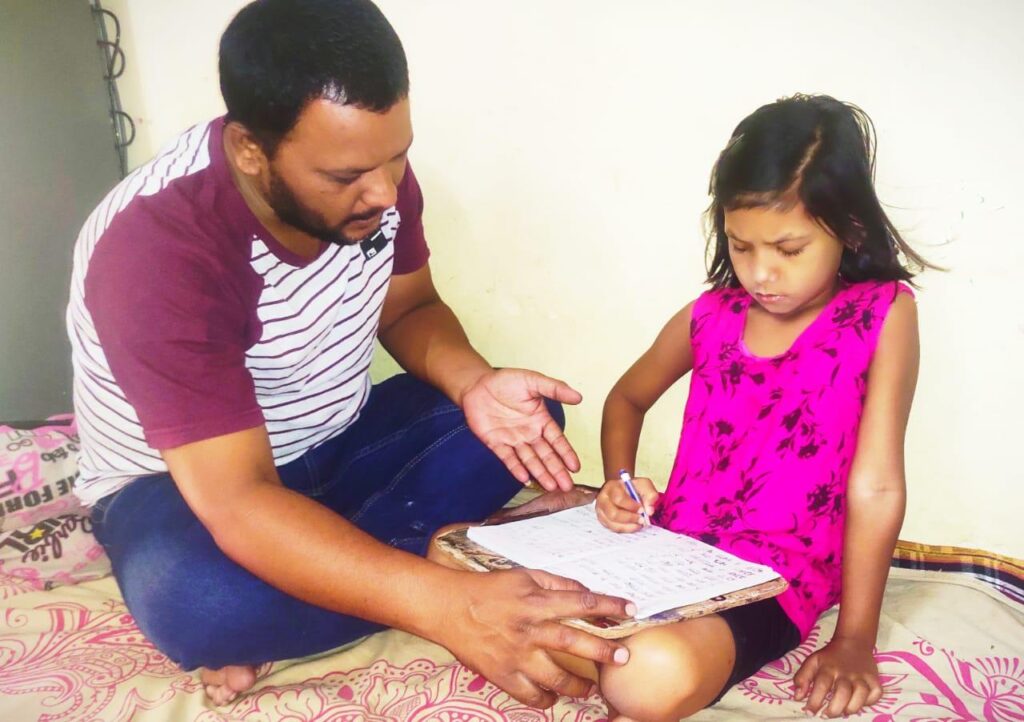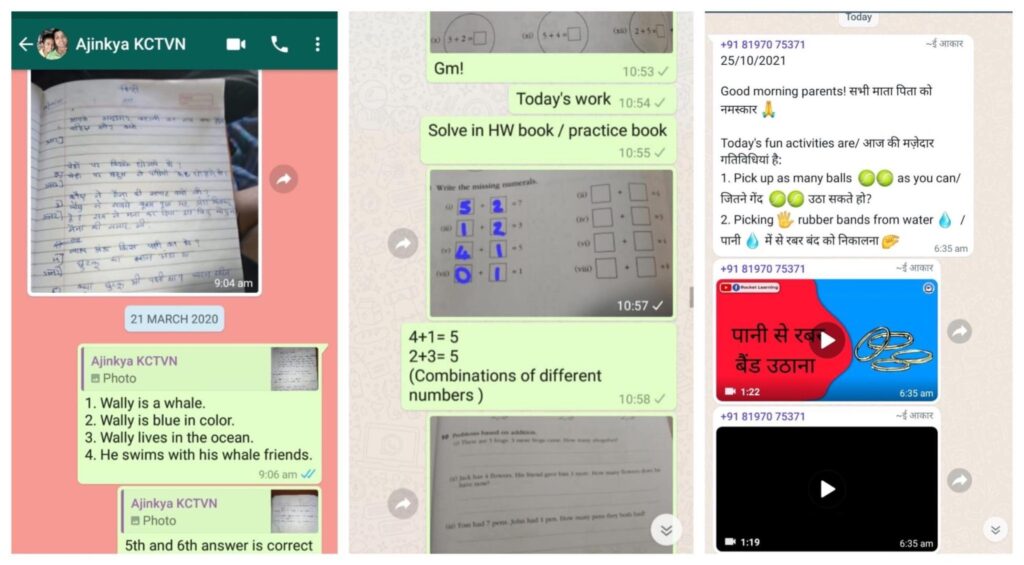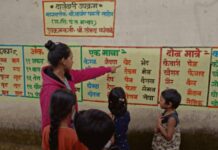UNICEF notes that “the quality of a child’s early experiences makes a critical difference as their brains develop, providing either strong or weak foundations for learning, health and behaviour throughout life.” Perhaps this is why early childhood education (ECE) is considered the foundation on which all future learning of a child is built. This stage of learning offers tremendous opportunities for the physical growth and cognitive development of children, enabling a greater possibility of overall gains and retention for children in education.
Yet, despite it being integral to lifelong learning and development, ECE has not been prioritised enough in India by the State.
The percentage of teachers for ECE is low—at a tiny 18%—in comparison to overall teacher availability for primary and secondary school education—which stands at 39% and 42% respectively. Furthermore, teachers for ECE earn the lowest salaries. ECE teachers in government schools earn an average monthly salary of ₹9,440 and in private schools, this stands at ₹8,946. This is lower than the average teacher salaries across grades—₹26,183 for government school teachers and ₹13,099 for private school teachers.
This is a serious concern given India’s ongoing learning crisis, which has been made worse by the pandemic and India’s digital divide and overall lack of digital literacy. With teaching and learning moving online since March of 2020, foundational learning, which is the focus of early grades, is set to slide even further down from current low levels. The Annual Status of Education Report for 2019 pointed to low levels of ECE learning: even by Grade 3, a substantial percentage of sampled children were well behind the learning expectations of Grade 1.
While the focus of discussion during a year of online classes has largely been on making technology accessible and available to students, a study by the Organisation for Economic Co-operation and Development (OECD) highlighted that to deliver on the promises that technology holds it is important to also build teacher capacities to use and access technology. More than ever, teachers, especially ECE teachers, need structural support to unlock these promises for India’s students.
“Starting from Scratch: The Role of Parents, Teachers, and Tech in Early Childhood Education during COVID-19”, a recent study by the Vidhi Centre for Legal Policy, fills the important gap of evidence on the status of Early Childhood Education (ECE) delivery during the pandemic in India. By examining the case of Mumbai and Pune—Maharashtra’s two urban metropolises—Vidhi’s research documents the experiences of 676 low-income households enrolled in Municipal Corporation of Greater Mumbai (MCGM) Balwadis (which are pre-schools for economically weaker communities) and The Akanksha Foundation schools for pre-primary schooling located in Pune and Mumbai [1].
It also accounts for the experience and challenges of teachers employed in both these ECE centres. Through in-depth conversations with 58 teachers (43 MCGM Balwadi teachers and 15 Akanksha teachers), the research captures teacher experiences with the digital modes of education, pedagogical adaptations made, changes in roles and responsibilities with school closures, and teacher’s experiences and opinions around the importance of parental engagement.
Its insights on the teachers and schools in Maharashtra who received support to leverage the potential of technology—and those who did not—may prove critical to reforming ECE as schools reopen across the country.
Teaching ECE During A Pandemic
The sudden onset of the pandemic created a range of challenges for ECE teachers surveyed to meaningfully continue delivering education.
In India, few teachers have the luxury of only teaching throughout the day: teachers can spend up to 20% to 25% of their weekly work hours performing administrative tasks for the school or local government. Teacher insights from the study further reflected that the workload and erratic work hours only increased during the pandemic. “In the past one year, since school closures, our workload has definitely increased”, says Sana, an Akanksha school teacher in Pune. “Our responsibilities have multiplied from just teaching to administrative work, checking trackers, and arranging parent meetings.”
While Balwadi teachers had to conduct home visits and distribute rations to the families of students, Akanksha teachers had to conduct ‘well-being calls’ with households once every fortnight, to check on how they were dealing with socio-emotional challenges of the lockdown, any issues with discipline or academics, and the overall well-being of the student.
This extra work has impacts that are undoubtedly gendered. All the teachers interviewed were women and they also reported challenges related to balancing work and home responsibilities. The lack of economic security they enjoy makes matters worse. The Balwadi teachers surveyed reported financial stressors being elevated during school closures—their meagre salaries of ₹5,000 per month were often delayed, and they faced the constant risk of losing their jobs. “We face a lot of issues personally as teachers,” says Anita, a Balwadi teacher in Mumbai. “We don’t receive our salaries on time. My husband has lost his job. Last year, we received our salaries for three months at one go, and even then, the payment came late. We need money to meet our personal expenses.”
The extra workload also severely inhibited an ECE teacher’s ability to effectively teach: which during the pandemic, also hinged upon parental cooperation. All teachers reported almost entirely relying on parents to deliver education during the pandemic, emphasising the role of parental engagement as critical for children’s overall development even beyond school closures. Studies further indicate that in spite of the many hours of school students sit through at a young age, parents are the primary source of education for students up to the age of seven.

Regardless of whether parents previously realised this responsibility, it nevertheless grew double-fold during the pandemic, with homes becoming the new classrooms. Many were not fully prepared to actively participate in their child’s learning and faced multiple barriers while engaging in ECE. These ranged from a lack of resources and capacity to engage due to work and other responsibilities, difficulties in acclimatizing to technology, and a lack of understanding of the importance of ECE and the strategies for teaching and learning at this age.
Owing to the limited teaching capacities of the parents, teachers and the school community had to come up with effective strategies to engage parents meaningfully in the teaching-learning process. This demanded that teachers learn how to use technology, and then communicate ECE lessons with parents effectively, while also fulfilling their administrative duties. This road was fraught with difficulties for teachers too.
“Parents don’t understand the use of technology, so they can’t explain the content of the lesson to the students,” says Nandini, a Balwadi teacher in Mumbai. “Teachers are also facing difficulties in using digital teaching methods. It is very important for teachers to also receive proper training on digital learning.” Some teachers reported struggling with the use and adaptation of technology in classrooms especially for ECE, which relies heavily on play-based methods and in-person social interactions as a part of teaching. This finding mimics the larger trends of teachers across India struggling with the shift to online learning during the early days of the pandemic.
Providing Teachers with Technological Support: What Worked and What Didn’t
The ability of teachers to eventually successfully manoeuvre technology largely depended on the kind of support they received.
The Akanksha schools received structured tech intervention through the E-Paathshaala program. This program, designed by Rocket Learning, uses low-tech and widely used digital platforms like WhatsApp to demonstrate age-appropriate and play-based activities that parents can perform with their children using household materials. It also sends content and nudges to parent WhatsApp groups to engage more parents, creating a ‘social pull’ through peer effects and incentives. Akanksha schools also received structured teacher support. Some of the Balwadis only received the structured tech intervention, while no structured teacher support was provided. The remaining Balwadis received this support sporadically, selectively and in a non-structured manner.

Across the three different groups surveyed, the households of students from Akanksha schools showed the highest levels of parental engagement, which were close to 20% higher than parents from the other two groups.
There were multiple features of the Akanksha model that may have favoured this rate: the balance between synchronous and asynchronous modes of engagement could be one of them.
WhatsApp was the most preferred mode of instruction for most teachers. Demonstration videos and other Teaching-Learning Material (TLM) were shared on parent WhatsApp groups. Parents had to conduct these activities with their children and send back pictures and videos of completed activities to the group. Holding synchronous and live classes on Zoom and Google Meet boosted parental engagement along with using asynchronous platforms like WhatsApp. Before they were inducted into these lessons, training sessions were held for parents on how to use Zoom and Google Meet to ensure that the integration of technology into learning was not an alienating factor for their engagement. Moreover, to ensure that parents were not intimidated by English learning material, teachers shared homework written and explained in Hindi and Marathi.


Additionally, keeping in mind the socio-economic backgrounds of the households, teachers knew that expecting parents to invest in materials commonly used in ECE—like clay, craft paper, and crayons—would be an additional financial burden for already distressed families. Teachers ensured that all activities were designed in a way that parents could make use of the materials available at home to facilitate learning. “Activities are not done just using books and pencils,” says Ayesha, an Akanksha school teacher in Pune. “We told parents that they can use rangoli powder [coloured powder], atta [flour], and other household items to study.”
Along with educational and learning support, teachers also reached out to households through wellbeing calls, to keep a check on their emotional wellbeing. They also distributed rations and other essentials, and spread awareness on COVID-19 and the vaccination process.
These services contributed to alleviating the financial and emotional distress faced by families due to the pandemic and to creating an environment within which parents can prioritise and engage with their children’s education.
ECE as Schools Reopen
While these strategies played a key role in enhancing parental engagement in Akanksha households in the midst of school closures, treating ‘parents as partners ’ has been a pillar of Akanksha’s vision since its inception in 1991. The pre-existing relationship of trust and collaboration between the school and parents acted as a stepping stone to engage parents meaningfully in virtual learning.
The study’s findings indicate a need for schools to sustain the impetus on parental engagement in schools—whether Akanksha’s, the MCGM’s or others—even after they reopen.
While teachers do not prefer a complete reliance on digital modes of ECE learning, the value of blended learning has been widely acknowledged by them. The use of low-cost, easy to use, and scalable technologies will be easier to adopt, especially for households from disadvantaged backgrounds. The success of the blended mode of learning will greatly depend on the availability of multilingual and contextually appropriate training material for teachers.
Finally, in order for parents to prioritize ECE, it will be pertinent to alleviate their existing barriers and help with their allied needs (like socio-emotional wellbeing, attention to nutrition, and other non-academic support), wherever possible. Teachers can be very useful in this process, however, adequate attention has to be given to the capacities, workload, job security, and overall well-being of teachers too.
All names have been anonymised to protect identity. | Featured image: parents teaching their children at home during the pandemic; courtesy of Akanksha Foundation.
[1] Balwadis are ECE Centres run by multiple NGOs through a Public-Private Partnership (PPP) model with MCGM, catering to low-income households in Mumbai. The Akanksha Foundation is a 30-years-old NGO running ‘innovative schools’ for children from low-income communities in urban Mumbai and Pune.






